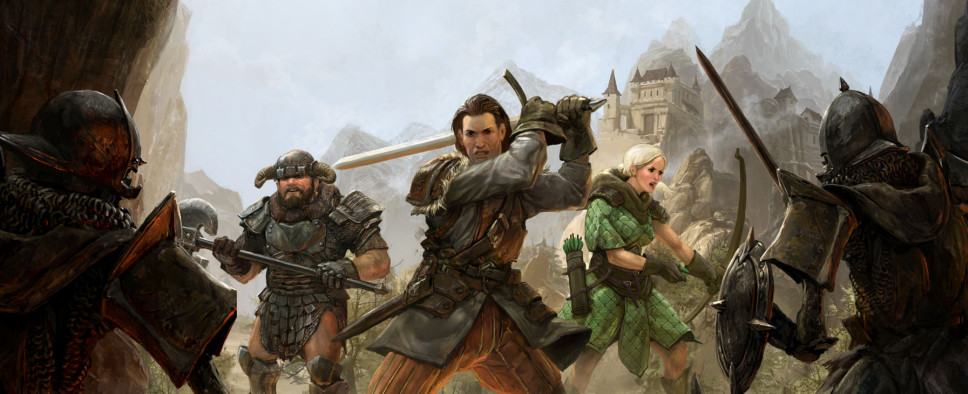Realms Beyond Blog Updates - Inspirations and Combat Grid
-
Category: News ArchiveHits: 1803

Head on over to the official Realms Beyond website and you'll find a couple of new developer blog posts. The first one tells us a bit about Phantasie, an obscure RPG that also happens to be one of Realms Beyond's major sources of inspiration, while the second one explains Ceres Games' decision to go with a hexagonal grid for the game's combat. Here are a few snippets:
By now we can safely assume that you have heard about roleplaying games, but have you ever heard of a Roleplaying Odyssey? Let me introduce you to Phantasie, a game where the front of the box promised such an experience. And for the most part, we can acknowledge that it pretty much reflects the memory we have of the game.
Looking back, Phantasie might have been a pure Ultima derivative. It featured a large world for you to explore on foot as you searched for the next town or dungeon. However, it did not feature 3D dungeons. Instead, you would kind of unveil the passages of each dungeon on some kind of map screen. The advantage was that you didn’t need to create a pen & paper yourself! Add a combat screen to the mix and you had what some of us considered to be the best RPG of 1985 for the Commodore C64. Better even than Ultima IV because it allowed players to create an entire party made up of different classes and races.
Phantasie also included a remarkable hidden feature. If you allowed the game to pick a character’s race at random, it would give you access to additional race that were not accessible otherwise. This way, suddenly, even Trolls and Pixies could be part of your party, aside from the standard choices of Human, Dwarf, Halfling, Elf or Gnome. All in all, Phantasie wasn’t the quest of the Avatar and his friends. This was a game that offered a large number of combinations when it came to the creation of characters!
Aside from the character system and party creation, the fondest memories of Phantasie spring from its exploration elements. Practically every step you took while you were exploring the world could trigger some kind of random encounter. If you were lucky, you would even surprise sleeping monsters and have the advantage! The world exploration made Phantasie feel open and almost limitless in its possibility to adventure and explore.
[...]
Combat System #2: Hexes vs. Squares
As you may recall, we touched upon this particular subject some time ago very briefly when we talked about our die rolling experiments with D&D 4th Edition: Six sides are better than four. Let’s elaborate.
This particular subject led to some of the most heated discussions among ourselves while we designed the combat system for Realms Beyond. There are times in the development cycle of a game that can lead to actual combat. Only in those cases, it typically gets resolved with arguments and words rather than the use of force and weapons.
Players of traditional D&D campaigns and those of the SSI Goldbox Games used to prefer dungeons and battlefields that were based on a square grid. Wargames and virtually every turn-based strategy game, on the other hand, favor hexagons. Modern D&D computer games, such as the Temple Of Elemental Evil, often abandoned a (visible) grid altogether, leaving game designers with three different approaches, each with its own crucial implications in regards to combat, level design, and spell handling.
After many lengthy exchanges discussing various arguments, in the end, we decided to settle upon a hexagonal grid. Perhaps the strongest argument for hexes was that they add more depth to combat. As I said before, six sides are just better than four. But there’s more to it. Here are three additional reasons that serve as viable arguments for hexes and against squares (or no grid at all).
Reason One: Movement Cost
Movement costs are more obvious. Unlike squares, where diagonal movement is actually longer and diagonal squares touch each other only in a single point, hex positions always share entire sides and crossing from one field into an adjacent one is always the same distance. In square grids, the game somehow has to account for the longer diagonal distance. Typically this is done by ignoring it and therefore providing a built-in exploit, as it becomes cheaper to move diagonally, instead of making the two straight moves that would otherwise be necessary to reach the same field. If you ever played D&D 4th Edition, which will allow you to move diagonally at the cost of one square, you will be well aware of the irresistible urge to exploit that apparent “extra ground” you can cover by moving diagonally.
Within a hex grid, you simply do not have that problem. Every move covers the same distance and can, therefore, safely have the same cost. We felt that in a computer game where you want to simply point at your target field and have the character move there by itself, it was not only much easier to calculate the path across a hex grid, but it was also more balanced because no movement points were squandered as a result of some awkward navigation.

